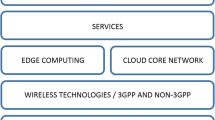Abstract
The demand for group communication using smart devices in campus environment is increasing rapidly. In this paper, we design an architecture for a mobile group communication system (MGCS) on campus by using Wi-Fi networks and smart devices. The architecture is composed of a web-based system and a smart device based mobile system. Through the systems, users on campus create community/mobile group, maintain dynamic group membership, and reliably deliver the message to other users. We use the common features of many smart devices to develop a prototype that works on off-the-shelf hardware. In the experimental section, we demonstrate our system using various real scenarios which can occur in university campuses.
Similar content being viewed by others
Explore related subjects
Discover the latest articles and news from researchers in related subjects, suggested using machine learning.References
Chatterjee S, Abhichandani T, Li H, Tulu B. Instant messaging and presence technologies for college campuses. IEEE Network, 2005, 19(3): 4–13
Suo Y, Miyata N, Morikawa H, Ishida T, Shi Y. Open smart classroom: extensible and scalable learning system in smart space using web service technology. IEEE Transactions on Knowledge and Data Engineering, 2009, 21(6): 814–828.
Moore E, Utschig T T, Haas K A, Klein B, Yoder P D, Zhang Y, Hayes M. H. Tablet PC technology for the enhancement of synchronous distributed education. IEEE Transactions on Learning Technologies, 2008, 1(2): 105–116
Bungo J, Embedded systems programming in the cloud-a novel approach for academia. IEEE Potentials, 2011, 30(1): 17–23
Moen D. Overview of overlay multicast protocols, available at http://netlab.gmu.edu
Cui Y, Li B, Nahrestedt K. oStream: asynchronous streaming multicast in application-layer overlay networks. IEEE Journal on Selected Areas in Communications, 2004, 22(1): 91–106
Francis P. Yoid tree management protocol (YTMP) specification. ACIR Center for Internet Research, 2000
Kwon M, Fahmy S. Topology-aware overlay networks for group communication. In: Proceedings of 2002 ACM International Workshop on Network and Operating Systems Support for Digital Audio and Video. 2002, 127–136
Banerjee S, Kommareddy C, Kar K, Bhattacharjee B, Khuller S. Construction of an efficient overlay multicast infrastructure for real-time applications. In: Proceedings of the 2003 IEEE Conference on Computer Communications. 2003, 1521–1531
Chu Y, Rao S G, Seshan S, Zhang H J. A case for end system multicast. IEEE Journal of Selected Areas in Networking, 2002, 20(8): 1456–1471
Gui C, Mohapatra P. Efficient overlay multicast for mobile ad hoc networks. In: Proceedings of the 2003 IEEE International Conference on Wireless Communications and Networking. 2003, 1118–1123
Wang W, Helder D, Jamin S, Zhang L. Overlay optimizations for endhost multicast. In: Proceedings of the 2002 ACM International Workshop on Networked Group Communication. 2002, 154–161
Xiang X, Zhou Z, Wang X. Robust and scalable geographic multicast protocol for mobile ad hoc networks. In: Proceedings of the 2007 IEEE Conference on Computer Communications. 2007, 2301–2305
Cheng H, Cao J, Chen H-H, Zhang H. GrLS: group-based location service in mobile ad hoc networks. IEEE Transactions on Vehicular Technology, 2008, 57(6): 3693–3707
Lim Y, Ahn S, Yu H. Region-based overlay multicast in mobile ad hoc networks. In: Proceedings of the International Conference on Consumer Electronics. 2008, 1–2
Basagni S, Chlamtac I, VSyrotiuk V R. Location aware, dependable multicast for mobile ad hoc networks. Elsevier Computer Networks, 2001, 36(5–6): 659–670
Chen K, Nahrstedt K. Effecive location-guided tree construction algorithms for small group multicast in MANET. In: Proceedings of the IEEE 2002 International Conference on Computer Communications. 2002, 1180–1189
Adam R, Jun L, Si Y T. MASH: the multicasting archie server hierarchy. ACM SIGCOMM Computer Communication Review, 1997, 27(3): 5–13
Patil A, Liu Y, Xial L, Esfahanian A H, Ni LM. SOLONet: sub-optimal location-adied overlay network for MANETs. In: Proceedings of the 2004 International Conference on Mobile Ad-hoc and Sensor Systems. 2004, 324–333
Chang N, Rashidzadeh RM, Ahmadi M. Robust indoor positioning using differential Wi-Fi access points. IEEE Transactions on Consumer Electronics, 2010, 26(3): 1860–1867
Cho S Y. Localization of the arbitrary deployed APs for indoor wireless location-based applications. IEEE Transactions on Consumer Electronics, 2010, 56(2): 532–539
Pace P, Aloi G, Palmacci A. A multi-technology location-aware wireless system for interactive fruition of multimedia contents. IEEE Transactions Consumer Electronics, 2009, 55(2): 342–350
Chou C-H, Ssu K-F, Jiau H C. Geographic forwarding with dead-end reduction in mobile ad hoc networks. IEEE Transactions on Vehicular Technology, 2008, 57(4): 2375–2386
Butler M. Android: changing the mobile landscape. IEEE Pervasive Computing, 2011, 10(1): 4–7
Suzuki T, Khan A, Kobayashi M, Takita W. Collaboration in routing and velocity measurement function for mobile ad hoc networks. In: Proceedings of the 2007 International Conference on Future Generation Communication and Networking. 2007, 108–113
Author information
Authors and Affiliations
Corresponding author
Additional information
Yujin Lim received the BS, MS, and PhD in Computer Science from Sookmyung Women’s University, Seoul, Korea in 1995, 1997, and 2000 respectively. From 2000 to 2002 she worked as a research faculty in the University of Seoul, Seoul, Korea. She worked as a research staff in the University of California Los Angeles from 2002 to 2003. She worked for Samsung Advanced Institute of Technology as a senior research engineer from 2003 to 2004. Since 2004, she has been an assistant professor in department of information media, University of Suwon. Her current research interests include ad hoc and sensor networks, mesh networks, and routing protocols over wireless environments.
Sanghyun Ahn is received the BS and MS in Computer Engineering from Seoul National University, Seoul, Korea, in 1986 and 1988, respectively, and received the PhD in computer science from University of Minnesota in 1993. She is currently a professor in the School of Computer Science, University of Seoul, Seoul, Korea. Her research interests include ad hoc and sensor networks, wireless networks, home networks, Internet protocols, and routing protocols.
Rights and permissions
About this article
Cite this article
Lim, Y., Ahn, S. Architecture for mobile group communication in campus environment. Front. Comput. Sci. 7, 505–513 (2013). https://doi.org/10.1007/s11704-013-1306-4
Received:
Accepted:
Published:
Issue Date:
DOI: https://doi.org/10.1007/s11704-013-1306-4




